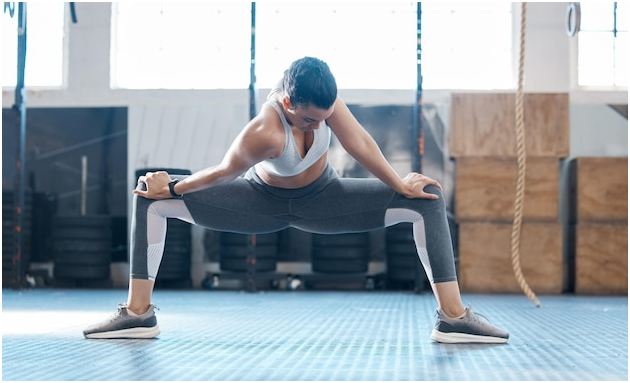As an avid fitness enthusiast, I have always understood the importance of a proper warm-up and cool-down routine before and after exercise. However, it wasn’t until recently that I truly realized the significance of calf stretching in preventing injuries. Calf stretching targets the muscles in the lower leg, specifically the gastrocnemius and soleus muscles. These muscles play a crucial role in maintaining balance, stability, and power during physical activities. By incorporating calf stretching into your post-workout routine, you can significantly reduce the risk of injuries and enhance your overall performance.
Other Exercises to Complement Calf Stretching.
While calf stretching is undoubtedly beneficial, it is essential to remember that a well-rounded fitness routine should include a variety of exercises targeting different muscle groups. To complement your calf stretching routine, consider incorporating horizontal pull exercises into your workouts. These exercises, such as rows and pull-ups, engage the muscles of the upper back and shoulders, promoting balanced muscle development and preventing imbalances that can lead to injuries. By incorporating horizontal pull exercises into your routine, you can improve your posture, strengthen your upper body, and enhance your overall athletic performance.

How Calf Stretching Prevents Injuries.
Calf stretching is not just a simple stretching exercise; it is a powerful tool in injury prevention. When we engage in physical activities, our calf muscles are subjected to significant stress and tension. If these muscles are not properly stretched and conditioned, they can become tight and shortened, which can lead to muscle imbalances, decreased range of motion, and increased risk of injuries. Regular calf stretching helps to lengthen the muscle fibers, improving flexibility and reducing the risk of strains, tears, and other common injuries. Additionally, calf stretching improves blood circulation to the muscles, facilitating faster recovery and reducing muscle soreness.
Tips for Maximizing the Benefits of Calf Stretching.
To maximize the benefits of calf stretching, it is essential to follow proper techniques and incorporate it into your routine effectively. Here are some tips to help you get the most out of your calf stretching exercises:
1. Consistency is Key:
Make calf stretching a regular part of your post-workout routine. Aim to stretch your calves at least three times a week to maintain flexibility and prevent muscle tightness.
2. Gradually Increase Intensity:
- Start with gentle stretches and gradually increase the intensity over time. Avoid bouncing or jerking movements, as they can lead to muscle strains.
3. Hold Each Stretch:
- When stretching your calves, hold each stretch for at least 30 seconds. This duration allows the muscles to fully relax and lengthen.
4. Combine Static and Dynamic Stretches:
- Incorporate both static and dynamic stretches into your routine. Static stretches involve holding a stretch in one position, while dynamic stretches involve moving through a range of motion. This combination helps to improve flexibility and mobility.
5. Listen to Your Body:
- Pay attention to how your body feels during the stretches. If you experience any pain or discomfort, adjust the intensity or technique to ensure you are stretching safely.
By following these tips, you can maximize the benefits of calf stretching and reduce the risk of injuries during physical activities.

Understanding the Calf Muscles.
To fully appreciate the importance of calf stretching, it is helpful to understand the anatomy of the calf muscles. The calf is made up of two primary muscles: the gastrocnemius and the soleus. The gastrocnemius is the larger, more superficial muscle, while the soleus is deeper and smaller. These muscles work together to enable movements such as walking, running, and jumping. They are also heavily involved in maintaining balance and stability. When we engage in physical activities that involve these muscles, such as running or jumping, they contract and generate force. Without proper stretching and conditioning, these muscles can become tight and prone to injuries.
Conclusion: Prioritizing Calf Stretching for Injury Prevention.
In conclusion, calf stretching is a crucial step in preventing injuries and enhancing athletic performance. By incorporating calf stretching into your post-workout routine, you can improve flexibility, reduce muscle tightness, and decrease the risk of strains and tears. Additionally, complementing calf stretching with horizontal pull exercises can promote overall muscle balance and prevent imbalances that can lead to injuries. Remember to follow proper stretching techniques, be consistent with your routine, and listen to your body’s signals. Prioritizing calf stretching will not only help you prevent injuries but also allow you to reach your fitness goals safely and effectively. So, make calf stretching a priority, and enjoy the benefits it brings to your fitness journey.
Remember to always consult with a healthcare professional before starting any new exercise routine.
CTA: Incorporate calf stretching and horizontal pull exercises into your post-workout routine today to prevent injuries and enhance your athletic performance. Start by stretching your calves for at least 30 seconds, three times a week, and gradually increase the intensity over time. Don’t forget to complement your calf stretching with exercises like rows and pull-ups to promote overall muscle balance. By prioritizing calf stretching and horizontal pull exercises, you can take a significant step towards injury prevention and optimal fitness.


